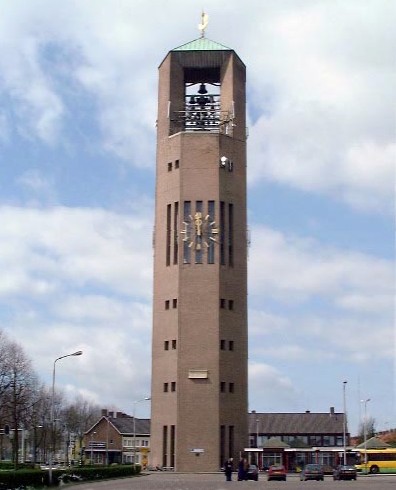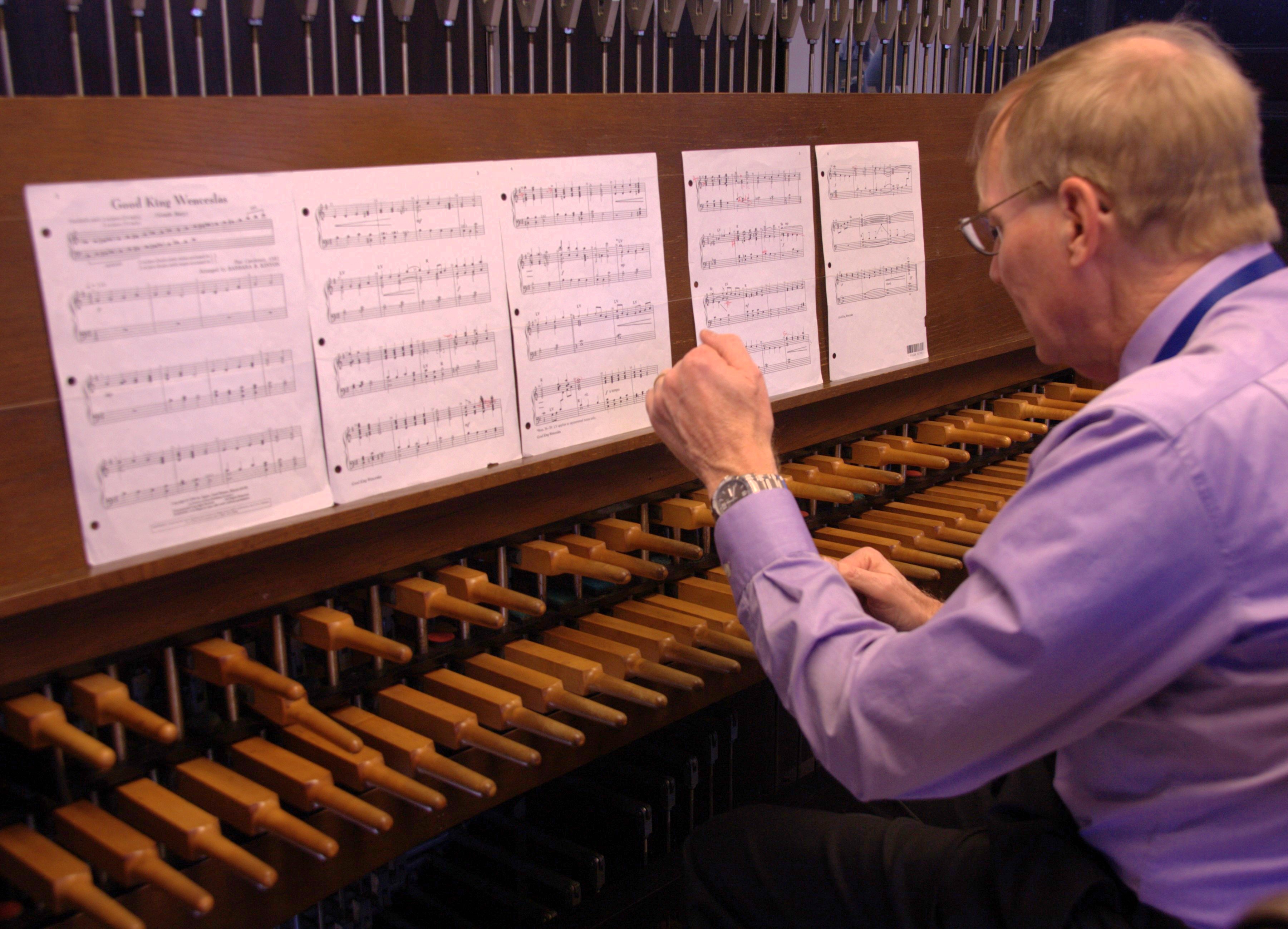|
Poldertoren
The Poldertoren is a water tower at the town center of Emmeloord, Netherlands. The Dutch name Poldertoren could be translated as Polder Tower. The 65-meter tower was built in 1959 and has a large carillon. The tower is no longer in use as a water tower. The owner of the tower was the water company, Vitens, but since 2005 the municipality of Noordoostpolder has owned the tower. A replica of this watertower exists in Japan. Details The tower measures 65.3 meters in height with a weather vane on top bringing the total height to 70.5 meters. Visitors can climb the 243 steps up to a height of 43.4 meters. The Poldertoren has a 13.4 meter diameter. The water storage capacity is 1.850 m3. Building materials for the tower included 1,220 m3 of concrete, 185 metric tons of steel, 600,000 bricks, 624 metric tons of cement and 7,200 drainpipes. Architects * J.W.H.C. Pot (Architectenbureau Pot en Pot-Keegstra) (1955–1959) * H. van Gent (1950–1959) History In an early design of ... [...More Info...] [...Related Items...] OR: [Wikipedia] [Google] [Baidu] |
Emmeloord - Poldertoren
Emmeloord is the administrative centre of the municipality of Noordoostpolder, Flevoland, Netherlands. In 2019, it had a population of 26,055. Overview At the heart of the Noordoostpolder, where the three main drainage canals Lemstervaart, Urkervaart and Zwolsevaart intersect, is the city of Emmeloord (1943). Named after an abandoned village on the island of , Emmeloord is located in a : land reclaimed from the |
Water Tower
A water tower is an elevated structure supporting a water tank constructed at a height sufficient to pressurize a distribution system for potable water, and to provide emergency storage for fire protection. Water towers often operate in conjunction with underground or surface service reservoirs, which store treated water close to where it will be used. Other types of water towers may only store raw (non-potable) water for fire protection or industrial purposes, and may not necessarily be connected to a public water supply. Water towers are able to supply water even during power outages, because they rely on hydrostatic pressure produced by elevation of water (due to gravity) to push the water into domestic and industrial water distribution systems; however, they cannot supply the water for a long time without power, because a pump is typically required to refill the tower. A water tower also serves as a reservoir to help with water needs during peak usage times. The water level ... [...More Info...] [...Related Items...] OR: [Wikipedia] [Google] [Baidu] |
Emmeloord
Emmeloord is the administrative centre of the municipality of Noordoostpolder, Flevoland, Netherlands. In 2019, it had a population of 26,055. Overview At the heart of the Noordoostpolder, where the three main drainage canals Lemstervaart, Urkervaart and Zwolsevaart intersect, is the city of Emmeloord (1943). Named after an abandoned village on the island of Schokland, Emmeloord is located in a : land reclaimed from the I ... [...More Info...] [...Related Items...] OR: [Wikipedia] [Google] [Baidu] |
Juliana Of The Netherlands
Juliana (; Juliana Louise Emma Marie Wilhelmina; 30 April 1909 – 20 March 2004) was Queen of the Netherlands from 1948 until her abdication in 1980. Juliana was the only child of Queen Wilhelmina and Prince Henry of Mecklenburg-Schwerin. She received a private education and studied international law at the University of Leiden. In 1937, she married Prince Bernhard of Lippe-Biesterfeld with whom she had four daughters: Beatrix, Irene, Margriet, and Christina. During the German invasion of the Netherlands in the Second World War, the royal family was evacuated to the United Kingdom. Juliana then relocated to Canada with her children, while Wilhelmina and Bernhard remained in Britain. The royal family returned to the Netherlands after its liberation in 1945. Due to Wilhelmina's failing health, Juliana took over royal duties briefly in 1947 and 1948. In September 1948 Wilhelmina abdicated and Juliana ascended to the Dutch throne. Her reign saw the decolonization and independ ... [...More Info...] [...Related Items...] OR: [Wikipedia] [Google] [Baidu] |
Carillons
A carillon ( , ) is a pitched percussion instrument that is played with a keyboard and consists of at least 23 cast-bronze bells. The bells are hung in fixed suspension and tuned in chromatic order so that they can be sounded harmoniously together. They are struck with clappers connected to a keyboard of wooden batons played with the hands and pedals played with the feet. Often housed in bell towers, carillons are usually owned by churches, universities, or municipalities. They can include an automatic system through which the time is announced and simple tunes are played throughout the day. Carillons come in many designs, weights, sizes, and sounds. They are among the world's heaviest instruments, and the heaviest carillon weighs over . Most weigh between . To be considered a carillon, a minimum of 23 bells are needed; otherwise, it is called a chime. Standard-sized instruments have about 50, and the world's largest has 77 bells. The appearance of a carillon depen ... [...More Info...] [...Related Items...] OR: [Wikipedia] [Google] [Baidu] |
Towers In Flevoland
A tower is a tall structure, taller than it is wide, often by a significant factor. Towers are distinguished from masts by their lack of guy-wires and are therefore, along with tall buildings, self-supporting structures. Towers are specifically distinguished from buildings in that they are built not to be habitable but to serve other functions using the height of the tower. For example, the height of a clock tower improves the visibility of the clock, and the height of a tower in a fortified building such as a castle increases the visibility of the surroundings for defensive purposes. Towers may also be built for observation, leisure, or telecommunication purposes. A tower can stand alone or be supported by adjacent buildings, or it may be a feature on top of a larger structure or building. Etymology Old English ''torr'' is from Latin ''turris'' via Old French ''tor''. The Latin term together with Greek τύρσις was loaned from a pre-Indo-European Mediterranean language, ... [...More Info...] [...Related Items...] OR: [Wikipedia] [Google] [Baidu] |
Bell Towers In The Netherlands
A bell is a directly struck idiophone percussion instrument. Most bells have the shape of a hollow cup that when struck vibrates in a single strong strike tone, with its sides forming an efficient resonator. The strike may be made by an internal "clapper" or "uvula", an external hammer, or—in small bells—by a small loose sphere enclosed within the body of the bell (jingle bell). Bells are usually cast from bell metal (a type of bronze) for its resonant properties, but can also be made from other hard materials. This depends on the function. Some small bells such as ornamental bells or cowbells can be made from cast or pressed metal, glass or ceramic, but large bells such as a church, clock and tower bells are normally cast from bell metal. Bells intended to be heard over a wide area can range from a single bell hung in a turret or bell-gable, to a musical ensemble such as an English ring of bells, a carillon or a Russian zvon which are tuned to a common scale and installe ... [...More Info...] [...Related Items...] OR: [Wikipedia] [Google] [Baidu] |
Ora Et Labora
The phrase pray and work (or 'pray and labor'; Latin: ''ora et labora'') refers to the Catholic monastic practice of working and praying, generally associated with its use in the Rule of Saint Benedict. History "Ora et labora" (pray and work) is the traditional motto of the Benedictines. Benedict ..."was renowned for handing on to his monks a balanced way of life – particularly with respect to contemplative prayer and active work, "ora et labora". He recognized the danger of letting one dominate, and the benefit of having both side-by-side." St. Benedict's Rule prescribes periods of work for the monks for "Idleness is the enemy of the soul" (RB 48.1). Benedict viewed prayer and work as partners, and believed in combining contemplation with action. Some orders applied the concept directly to farm work and became an element in the movement towards land reclamation from rot and agricultural development in Western Europe. Other orders such as the Humiliati applied the conc ... [...More Info...] [...Related Items...] OR: [Wikipedia] [Google] [Baidu] |
Cornelis Lely
Cornelis Lely (; 23 September 1854 – 22 January 1929) was a Dutch politician of the Liberal Union (LU) and civil engineer. He oversaw the passage of an act of parliament authorising construction of the Zuiderzee Works, a huge project – designed to his own plans – that turned the Zuiderzee into a lake and made possible the conversion of a vast area of former seabed into dry land. Early life Cornelis Lely was born on 23 September 1854 in Amsterdam in the Netherlands, son of an oilseed trader. Lely went to the Hogere Burgerschool (HBS). He later studied at the Polytechnic School in Delft and graduated as civil engineer in 1875. Career outline Between 1886 and 1891, Lely led the technical research team that explored the possibility, later approved by a State Commission, of enclosing the Zuiderzee. The Dutch parliament passed the law creating the Zuiderzee Works on 14 June 1918, using Lely's plan. He served three times as Minister of Transport and Water Management (in 189 ... [...More Info...] [...Related Items...] OR: [Wikipedia] [Google] [Baidu] |
Overijssel
Overijssel (, ; nds, Oaveriessel ; german: Oberyssel) is a province of the Netherlands located in the eastern part of the country. The province's name translates to "across the IJssel", from the perspective of the Episcopal principality of Utrecht by which it was held until 1528. The capital city of Overijssel is Zwolle (pop. 127,497) and the largest city is Enschede (pop. 158,986). The province had a population of 1,162,215 as of November 2019. The land mostly consists of grasslands and some forests (including Sallandse Heuvelrug National Park); it also borders a small part of the IJsselmeer to the west. Geography Overijssel is bordered by Germany (Lower Saxony and North Rhine-Westphalia) to the east, the Achterhoek region of Gelderland to the south, the Veluwe region of Gelderland and Flevoland to the west, and Friesland and the former moors of Drenthe to the north. Overijssel comprises three regions: Kop van Overijssel in the northwest, Salland in the centre ... [...More Info...] [...Related Items...] OR: [Wikipedia] [Google] [Baidu] |
Amsterdam
Amsterdam ( , , , lit. ''The Dam on the River Amstel'') is the Capital of the Netherlands, capital and Municipalities of the Netherlands, most populous city of the Netherlands, with The Hague being the seat of government. It has a population of 907,976 within the city proper, 1,558,755 in the City Region of Amsterdam, urban area and 2,480,394 in the Amsterdam metropolitan area, metropolitan area. Located in the Provinces of the Netherlands, Dutch province of North Holland, Amsterdam is colloquially referred to as the "Venice of the North", for its large number of canals, now designated a World Heritage Site, UNESCO World Heritage Site. Amsterdam was founded at the mouth of the Amstel River that was dammed to control flooding; the city's name derives from the Amstel dam. Originally a small fishing village in the late 12th century, Amsterdam became a major world port during the Dutch Golden Age of the 17th century, when the Netherlands was an economic powerhouse. Amsterdam is th ... [...More Info...] [...Related Items...] OR: [Wikipedia] [Google] [Baidu] |








.jpg)